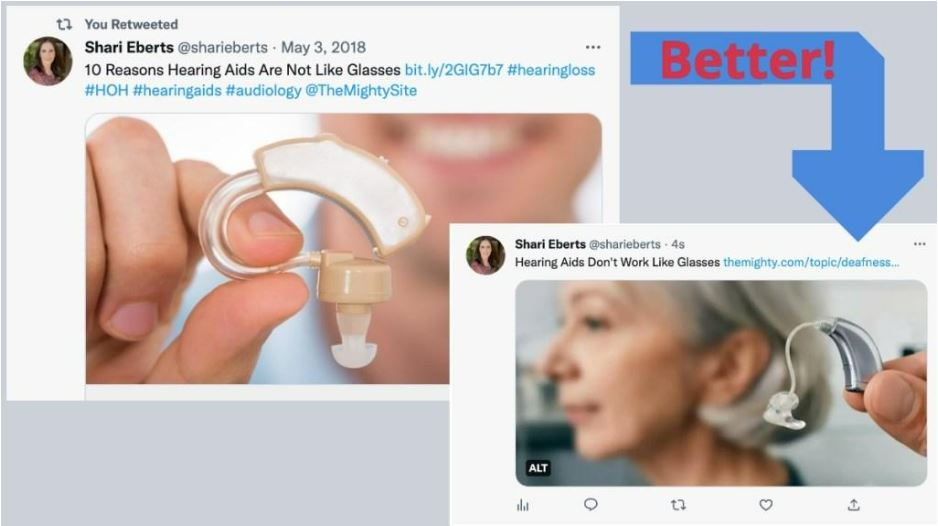Which image below do you think paints hearing loss and hearing aids in a realistic light?
Clearly, the one on the bottom right. But not everyone in the mainstream knows this, especially when bombarded by inaccurate and outdated hearing aid imagery on a regular basis. Amid all the media buzz surrounding the launch of OTC hearing aids, only a very few articles included accurate and modern looking hearing aids in their coverage. In fact, most of the images pictured devices that haven’t been used for decades. I can’t think of a quicker way to deter an on-the-fence OTC hearing aid user still battling stigma and uncertainty from taking the first step into hearing devices.
A big thank you to The Mighty Site for updating the below image when asked by Hearing Loss Live. Proper representation helps beat back the stigma that still surrounds using hearing aids.

Outdated and inaccurate images portraying hearing aids gives the wrong impression to the public and may be contributing to stigma
Modern Hearing Aid Images are Hard to Find
Why do news stories regularly feature outdated images of hearing aids? Because they are the only images that are readily available. Search iStock photo by Getty Images and you’ll see a wide array of unacceptable options with only a few modern images in the mix. The same is true for free image sites, although I recently discovered some attractive images on Unsplash. Thank you Mark Paton for taking these photos and making them widely available for free.
But we need more. Realistic images show hearing aids as the attractive modern devices that they are, helping reduce stigma and perhaps even lowering resistance to use them.
A Challenge to the Hearing Care Industry
It’s time for the industry to take matters into their own hands. Perhaps a hearing aid company (or two) and/or a hearing care professional organization (or two) could join forces to create and donate attractive unbranded hearing aid images for public use. This would be a terrific way to not only support people with hearing loss but also to invest in the future growth of the hearing care industry.
A similar project was done in a related field. In 2019, AARP collaborated with Getty Images to counteract stereotypes surrounding aging by creating the Disrupt Aging Collection, a paid library of more than 1,400 images that paint a more accurate portrait of how people age in today’s society — free of ageist stereotypes.
Who wants to create a similar library of free images for hearing devices?
An OTC Ad that Breaks Down Stigma
There are rays of hope and some progress. The humor and use-case portrayed in the below ad would certainly make potential users feel more comfortable to learn more.
Let’s hope more ads like this are on the way for both OTC and traditional hearing devices. The more playful the industry can be with imagery and message, the more normalized hearing devices will become.
And then, stigma might finally wither away.

Shari Eberts is a passionate hearing health advocate and internationally recognized author and speaker on hearing loss issues. She is the founder of Living with Hearing Loss, a popular blog and online community for people with hearing loss, and an executive producer of We Hear You, an award-winning documentary about the hearing loss experience. Her book, Hear & Beyond: Live Skillfully with Hearing Loss, (co-authored with Gael Hannan) is the ultimate survival guide to living well with hearing loss. Shari has an adult-onset genetic hearing loss and hopes that by sharing her story, she will help others to live more peacefully with their own hearing issues. Connect with Shari: Blog, Facebook, LinkedIn, Twitter.







Bravo!
Also graphics and photos for Assistive Listening Systems signs, including hearing loop signs, need to use the International Symbol of Access for Hearing Loss, as described in the ADA standards, Figure 703.7.2.4
A great article! As a graphic designer I manage our HLAA Chester Co website and prepare our newsletter.
I added the link to my info base for hearing aid images. Thank you.
I did feel compelled to look into the Sennheiser Conversation Clear Plus and I think they are only amplifiers not FDA approved OTC hearing aids.
I found the video entertaining and yes hopefully the hearing aid industry will use more advertising like this to promote acceptance of hearing aids.
The issue of images goes deeper than style. Regrettably, manufacturers in their marketing feature images of tiny, near-invisible hearing aids. This plays to consumer stigma – fear of being seen as old and “near deaf” – and hinders the inclusion of telecoils for assistive listening in devices because the very smallest hearing aids don’t have room for them.
maybe just a few comments on how silly apple air buds look sticking out of people’s ears look.. and that’s an accepted norm now. I prefer my OTICON OPN 1 with killer music and hands free phone calls with my connect clip.